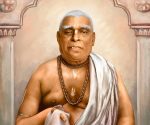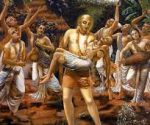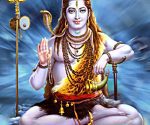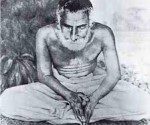The Glories of Ramanujacarya
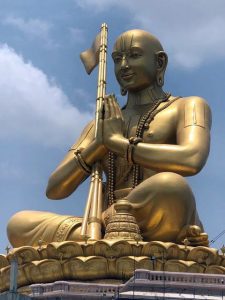 Srila Bhaktivedanta Narayana Goswami Maharaja – Hawaii 2007, Mathura 2000 [in brackets]
Srila Bhaktivedanta Narayana Goswami Maharaja – Hawaii 2007, Mathura 2000 [in brackets]
Sri Ramanujacarya was born in South India. He is an incarnation of Laksmana. The word ‘anuja’ means ‘younger brother’. Rama-anuja refers to the younger brother of Lord Rama; therefore, he is Ramanuja. In Kali-yuga, he is the acarya of the Sri (Laksmi) Sampradaya. He is the disciple of Yamunacarya.
As a boy, he was exceptionally intelligent. At a very young age, he knew all Sanskrit grammar (vyakarana), literature (sahitya), and all the deep conclusions of the Vedic scriptures.
[Sri Ramanujacarya is an incarnation of Laksmana (Lord Rama’s younger brother), and he accepted the Sri Sampradaya. Srila Bhaktisiddhanta Sarasvati Thakura Prabhupada took many teachings from him, such as the duties of the sannyasi, the duties of the disciple, and the etiquette of the Vaisnava. He utilized one-hundred eight teachings. We follow these teachings, and we have also published them in our Bhagavata Patrika and Gaudiya Patrika (Hindi and Bengali Magazines).]
His teacher, Yadavacarya, was a follower of the Mayavada (the theory that all variety and individuality are illusion) and Advaitavada (the theory that the only truth is impersonal undifferentiated oneness) philosophies. One day, his teacher began to explain his understanding of the beauty of Sri Krsna’s eyes. In this regard Chandogya Upanisad uses the word ‘kapyasam.’ Yadavacarya explained that ‘kapi’ means ‘monkey’, and that the monkey’s rear-end (kapi-asam) is reddish on both sides. He concluded that Krsna’s lotus eyes are like a monkey’s rear-end. Hearing this, Ramanuja began to weep.
Later, when Ramanuja was massaging Yadavacarya, he told him, “The explanation you have given for kapyasam is wrong. ‘Kapi’ can be understood to mean ‘that which takes water from everywhere’. Who takes water? The sun. The word ‘asam’ also means ‘to blossom’, so the word ‘kapi-asam’ can be understood as ‘that which blossoms under the sun,’ or, in other words, ‘the lotus flower’. Thus, we can understand the verse to mean that the Lord’s eyes are as beautiful as the lotus flower.”
[Sri Ramanujacarya took birth in a simple family. His mother and father were not very wealthy, but they were of a high brahmana caste and they were very learned. Ramanuja was an outstanding boy from his childhood. While under the guidance of a Mayavadi guru named Yadavacarya, he was very careful in his studies. One day, when his guru was giving an impersonal explanation of a verse that contained the word kapyasana, he compared the lotus-eyes of the Lord to the hind part of a monkey which is reddish near its tail. Hearing this from his gurudeva’s mouth, Ramanuja began to cry in great pain. He felt grief in his heart that his gurudeva had used such a bad analogy for describing the lotus-like eyes of the Lord. After collecting himself, he very politely asked if he could say something about the verse. Yadavacarya assented, and Ramanuja very nicely gave many explanations according to Sanskrit grammar. He said that the term kapyasana actually means one who brings water, and that is the sun. The lotus blossoms by the potency of the sun, and therefore the Lord’s eyes are compared to the lotus, not the monkey.]
Ramanuja’s teacher became astonished, thinking, “If this boy is so knowledgeable at such a young age, what will he do when he is grown up? If he remains alive, this Mayavada teaching will be finished.” His teacher then planned to murder him.
[When Yadavacarya heard this, he thought, “This boy is dangerous. He is very expert and is giving such nice explanations. In the future he might uproot all the impersonal teachings from the Vedas, and so I must kill him.”]
Thinking to trick Ramanuja, Yadavacarya told him that he was going to travel with all his students to do some preaching, and that Ramanuja should also accompany them. Ramanuja was a very sincere and innocent boy, so he didn’t understand his teacher’s intentions.
Then, when they were all in a very deep forest, they decided that this would be the time to murder him. Govinda, his cousin-brother, told him of their plan, and urged him to quickly flee from there. Therefore, in the middle of the night, Ramanuja told them that he was going to the toilet, and he ran away.
Now alone, he suddenly saw a hunter, along with his wife, holding a hurricane light. The man asked him, “Where are you going?”
Ramanuja answered, “I am going to Kancipuram.”
The man replied, “We are also going there, so come with us.”
When he arrived at Kancipuram, his own village, which was very far away, those persons disappeared. Ramanuja then began to weep. He understood that it was certainly the Supreme Personality of Godhead, Narayana Himself, along with His eternal consort, Laksimi-devi, who had saved his life.
[Throughout the day and night, he passed through the dense forest. It was difficult for him to discern his way, especially at night. The Lord, seeing His dear devotee in such a state, then appeared in the form of Bharadraja and, holding a lantern in His hand, showed Ramanuja the way. Thus, within no time at all, Sri Ramanuja crossed the entire distance of the forest and found that he was standing outside his village.]
Sometime later, Ramanuja’s teacher returned to the village. He had been thinking that perhaps a lion or tiger had eaten Ramanuja, and he was very happy. However, when he arrived, he saw that Ramanuja was alive. He called him and told him to forget everything that had happened, Ramanuja again resumed his Sanskrit studies with Yadavacarya.
[After some days, out of compassion for Yadavacarya and with a desire to deliver him, he again began studying under his guidance. After some years, Ramanuja converted Yadavacarya to Vaisnava philosophy, whereupon his teacher became his disciple. At one point thereafter, Ramanuja began hearing of the qualities of a great Vaisnava guru in South India by the name of Sri Yamunacarya, and he eventually became Sri Yamunacarya’s disciple.]
Later he married. After his marriage, he began to teach boys in a Sanskrit school, and all the students liked him.
[Later on he married, and his wife was very quarrelsome. Her behavior was discourteous and uncooperative, and incidents would often take place which he would somehow have to tolerate.]
One day, a disciple of Sri Yamunacarya named Kancipurna came to the house of Ramanuja. He was from a very low-caste family, but he was a very high-class devotee. He came there along with his wife by the order of his Gurudeva, and he now began to give his association to Ramanujacarya.
[A disciple of Sri Yamunacarya and elder god-brother of Ramanuja named Kancipurna came to Ramanuja’s village along with his wife. Ramanuja accepted Kancipurna as a siksa-guru.]
One day, when Ramanujacarya’s wife was drawing water from the well, Kancipurna’s wife was also there drawing water. Some water from the bucket of Kancipurna’s wife fell into Ramanuja’s wife’s bucket. She immediately became very angry and started to insult the wife of Kancipurna with abusive language. When Kancipurna returned, his wife told him of the incident at the well, and he immediately left the house of Ramanujacarya. Upon hearing the reason why his siska-guru had departed, Ramanujacarya began to think, “I should not be with this lady. Somehow, I should give her up right away.”
[One day, when Kancipurna’s wife was taking some water from a well, she met Ramanuja’s wife, who had also come to the well for drawing water. It so happened that while taking the water out of the well, some water from the pot of Kancipurna’s wife spilled into the pot of Ramanuja’s wife. Although this was a small accident, Ramanuja’s wife became furious and insulted Kancipurna’s wife with abusive language. Kancipurna became hurt when he later on heard about this, and, without informing Ramanuja, he and his wife left that place and went to Sri Rangam. When Sri Ramanuja came to know that his wife’s behavior had offended a Vaisnava, he felt very bad and thought, “She is committing vaisnava-aparadha; she has such an offensive mentality. I must do something about this.”]
Later, Sri Yamunacarya sent Purnacarya to bring Ramanuja to him in Sri Rangam. However, Yamunacarya was very sick at that time, and, by the time Ramanuja arrived in Sri Rangam, he had departed from the vision of the world. Purnacarya, was sent there to bring him to Sri Rangam. Ramanuja used to give him so much honor – always offering him obeisances and treating him like his siksa-guru. While living with Ramanuja, Purnacarya began to impart the instructions he had received from his Gurudeva, Sri Yamunacarya.
One day, when Ramanuja was teaching at the school, a hungry brahmana came there. Ramanuja told him, “If you go to my house to beg, my wife will give you something.” However, when the brahmana went there, Ramanuja’s very cruel wife said, “I can’t give you anything. Go! Get out of here!” The brahmana returned to Ramanuja, who then told him to go back to his house and tell my wife, “I am coming from the house of your father. He sent me to you, so please take this letter from him.” Ramanuja personally wrote the letter he gave to the brahmana to deliver to his wife. The letter stated, “Your brother will marry very soon, so you must come to your father’s house.” After reading the letter, Ramanuja’s wife began to honor that brahmana, and she gave him a large quantity of delicious prasadam.
[One day, a hungry brahmana came to Ramanuja, asking for some food. Ramanuja sent this brahmana to his wife, telling him, “Go to my home and tell my wife that I sent you. She will give you some food.” When that brahmana came to Ramanuja’s wife, she boldly insulted him again and again. She told him he should get out of there, and that there was no food for him. Returning to Ramanuja, the brahmana reported what had happened, and Ramanuja replied, “Wait here for a few minutes.” He left and wrote a letter to his wife, as though it was written by her father, stating, “O my dear daughter, I am arranging the marriage of my son, your brother. So you should come. Please bring your husband with you.”
Writing these words very nicely, he folded that letter and tied it with colorful threads. And, along with that, he sent a coconut and other auspicious items. He then gave that letter to the brahmana and said, “Now go again to my wife. She will welcome you nicely this time. The brahmana went again. After reading the letter, Ramanuja’s wife’s behavior completely changed. This time she welcomed him warmly and sweetly, and offered him all kinds of palatable food and sweets. When Ramanuja came home, his wife told him about the marriage. She cited her father’s request for both of them to come, and requested him to please come along.
Ramanuja said, “No, I cannot come, for I am very busy; you may go now with this brahmana. Don’t be late.”]
When his wife left to go to the house of her father, Ramanuja also left that house. He went to Sri Rangam to meet his Gurudeva, Sri Yamunacarya, but Yamunacarya had left his body just before Ramanuja arrived. Ramanuja saw that many devotees were walking with the transcendental body of Yamunacarya. All of his disciples were weeping as they carried his body to be placed in samadhi.
[After his wife left with that brahmana, Ramanuja locked the door of his house and went to Sri Rangam to meet his Gurudeva, Sri Yamunacarya. He wanted to take sannyasa from him, but when he reached Sri Rangam, he found that Sri Yamunacarya had just passed away and his disciples were walking in procession with his divine body. Ramanuja felt very disheartened and sad.]
He told them, “I have accepted Yamunacarya as my Gurudeva. I want to see his face.” Yamunacarya’s disciples stopped and lifted the cloth from his body. Ramanuja could see that three of Yamunacarya’s fingers were folded.
[He asked them to stop for a moment. He wanted them to uncover the transcendental body so that he could take darsana of his Gurudeva’s divine form. He observed that all the fingers on one of his Gurudeva’s hands were open, and on the other, three fingers were closed. He inquired from the disciples all around as to why this was, and he wanted to know when it happened. No one could answer. They said, “We didn’t notice it before; it must have happened just now.”]
He promised in front of all present, ‘I will write the Sri-bhasya commentary on the Vedanta-sutra.” One of the fingers immediately became straight. He then said, “I will take sannyasa,” and the second finger relaxed. Lastly, he said, “I will preach the mission of my Gurudeva, Yamunacarya”, at which time the last finger relaxed and became straight. Seeing this, everyone present became astonished.
[Ramanuja became silent, and after some time he spoke, addressing Sri Yamunacarya’s transcendental body. He said, “Now, I will first of all write a Vaisnava commentary on Vedanta, and I will preach that Vaisnava commentary throughout India.” One finger opened, and Ramanuja spoke further, “I will take tridandi-sannyasa right now, and I will preach the message of vaisnava-dharma and your teachings.” When Sri Yamunacarya heard that, his second finger opened. Ramanuja then said, “I will systematically write about Vaisnava etiquette, explaining the behavior required to execute pure devotional service, and what precautions should be taken. I will also preach this throughout India.” After uttering this third statement, Sri Ramanujacarya observed, along with all present, that three of Yamunacarya’s fingers had now opened. Then and there, Sri Ramanujacarya formally accepted tridandi sannyasa from Sri Yamunacarya.]
After Yamunacarya was given Samadhi, Ramanujacarya was elected to become the next acarya, as Yamunacarya’s successor. He immediately said, “I will not become the next acarya right away. Give me time. Give me two years.” He then spent some time with each of the prominent disciples of Yamunacarya. He served them and heard from them what they had learned from their Gurudeva. Only after hearing from them for two years did he accept the post of acarya.
[Sri Ramanujacarya had now formally taken sannyasa initiation from Sri Yamunacarya. Afterwards, all the disciples of Sri Yamunacarya, who were great scholars and who had served their Gurudeva for so many years, came together. Having seen the extraordinary characteristics and personality of Sri Ramanujacarya, they collectively decided that he should be appointed as the next acarya after their Guru, and they honored him with the acarya seat in Sri Rangam. Sri Ramanujacarya accepted the orders of his god-brothers, but before sitting and acting as the acarya, he went to each of his god-brothers, for two months, four months, six months, or one year, and served each of them. He thus formally endeavored to understand the teachings of Sri Yamunacarya, since he had not gotten the opportunity to spend much time with him. After serving and satisfying them, he commenced his role as acarya of the Sri Sampradaya in Sri Rangam.]
Later, the ruler of that country, King Koluttunga II, heard that Ramanujacarya was very strongly preaching his philosophy. Koluttunga II wanted him killed, fearing that if he remained alive, the Saiva Sampradaya (comprised of so-called devotees of Lord Siva) would be finished. He sent a message telling Ramanujacarya to come at once for a debate.
Ramanujacarya and all his associates knew that the king wanted to kill him. His disciple Kuresh told him, “Gurudeva, please do not go. I will go in your place. Please give me your danda and sannyasa cloth.” Insisting, Kuresh took them from him and gave him his own white cloth. He told Ramanuja to leave that place at once. Then, having taken his Guru’s sannyasa cloth and danda, Kuresh went to the palace of the king.
In the palace there was a great debate, during which Kuresh defeated all the king’s pandits. However, Kuresh was alone, so the king’s pandits told everyone that he had been defeated. They forcibly detained him, and only released him after blinding him by plucking out both of his eyes. He then began to search for his Gurudeva, who was now very far away. Fortunately, after some time, he came to the same village where Ramanujacarya was residing.
Within that village there were two disciples – one very rich and one very poor. Ramanujacarya told his disciples to go to the house of the rich devotee, because his group was more than fifty in total, and ask him to prepare prasadam and a place to stay for all of them.
Two of Ramanuja’s disciples went to the rich man’s house and gave him this message. The rich man felt extremely happy and became totally absorbed in preparing for the arrival of Ramanujacarya and all of his devotees. However, he didn’t come back out to share these plans with his two god-brothers at the door. After waiting for some time, those disciples went back to Ramanujacarya and told him that they had gone to the house of that rich devotee, but he had left them waiting and had not come back to them. Ramanujacarya replied, “Oh, then we will all go to the house of that poor man.”
That very poor brahmana used to go and beg for ingredients so that his wife could cook prasadam. He had only one piece of proper cloth, which his wife used, so when he would go begging, he would take the cloth of his wife.
On that particular day, after midday, he could not collect any more, and he decided to return home. In the meantime, before his return, Sri Ramanujacarya, with all of his disciples, suddenly came to his house. His wife was very happy to see her Gurudeva, but she also felt very ashamed because she had no proper cloth to wear. Sri Ramanuja understood this, and he gave her his own chadar. She wrapped this around herself and came in his presence.
After she gave a mat for her Gurudeva and his followers to sit on, she began to wonder, “How shall I arrange prasadam for everyone?” She remembered that one of her neighbors, who was a rich businessman, was very attracted to her and had lusty desires toward her. He had previously told her of his desires, but she was very chaste and had always rejected his proposals. However, in her current predicament, she went to that man and told him that she would fulfill his desire.
She was thinking, “What is the use of my chastity if I cannot serve my Gurudeva? For my Gurudeva, I should be prepared to do anything.” She told that rich man, “I am ready to do what you want, but in return I want you to arrange many ingredients so that I can cook and give prasadam to my Gurudeva and all of his disciples.” Hearing this, the rich man became very joyful and gave her more than what she wanted. Taking all that he gave her, she prepared very good prasadam for all the devotees, and everyone was happy.
While Ramanujacarya and all the devotees were resting after prasadam, her husband returned home. He asked her, “Gurudeva and all his disciples have come. How are we going to arrange for their needs?”
She replied, “I have done everything. There is nothing to worry about. They have all taken prasadam and are resting now.”
Her husband asked, “How did you make all those arrangements?”
She began to tell him the story about the lusty neighbor. She said, “I was thinking that my Gurudeva has come; if I cannot serve him, then what is the use of my chastity? So I went and told that lusty man that if he would give me all the ingredients to make very nice prasadam, then I would offer myself. He did as I asked, so now that it is night I must go to him.”
Her husband told her, “I will come with you.”
It was raining at that time, so they took an umbrella and went to the house of that rich person along with the mahaprasadam. The wife entered his home alone, and the man became very happy. The man asked her, “It is raining heavily tonight, and it appears you have come all alone. Didn’t anyone bring you?” She told him, “My husband came with me,” and she gave him the prasadam remnants of Ramanujacarya. The lusty man took those remnants and became totally transformed. He fell flat at the lotus feet of that lady and begged her, “Excuse me. Excuse me.”
The lady and her husband then returned to their house. The next day, their neighbor came to Ramanujacarya and prayed to him, “I want to be initiated by you.” Ramanujacarya then initiated him.
In the meantime, Kuresh arrived in the village of the poor devotee couple where Ramanujacarya was staying. Seeing Kuresh, Ramanujacarya called out his name. Kuresh went to his Gurudeva and wanted to take his darsana, but he had no eyes. Ramanujacarya put his hand over Kuresh’s wounds and two eyes at once manifested. He could see again.
Afterward, Ramanujacarya went to North India. After traveling for a long time, he eventually arrived in Kashmir. He went to Sarada-pith, the place of Sarada-devi, where he came across the Bodhayana-bhasya (commentary) of Vedanta-sutra. This Bodhayana commentary contained Vaisnava philosophical conclusions, not Mayavada theories. In the library at Sarada-pith he read that commentary, and in the night he took that book and escaped with Kuresh
They fled from there, but the Kashmiri pandits followed them. Finally, the pandits took the book and returned to their own place. Ramanujacarya was very unhappy, but Kuresh told him, “Gurudeva, do not be unhappy. I have also read that book, and I remember all its contents. I will write them down.” Later he did this, and he gave the writings to Ramanujacarya. Ramanujacarya then wrote his Sri-bhasya on Vedanta-sutra [* See Endnote] and fulfilled the three desires of his Gurudeva, Yamunacarya.
[When Sri Ramanujacarya officially became the acarya, he began very strongly preaching the cult of Sri Yamunacarya. In South India, two impersonalist sects are very prominent: Saiva and Sankaracarya. Sankaracarya’s followers subscribe to the Vedanta sutras like “sarvam kalvidam brahma” and “tat tvam asi.” They think themselves impersonal brahma (God), and they think everything comes from brahma. The Saiva School considers Lord Siva to be the ultimate truth, and they want to merge into him. This is the basic difference between the two. Sri Ramanujacarya refuted and defeated all impersonalism by his very strong and effective preaching.]
Gaura premanande
[*Endnote: Sri Ramanujacarya has also refuted the arguments of Sankara in his own commentary on the Vedanta-sutra, which is known as the Sri-bhasya: “Sri Sankaracarya has tried to equate the Pancaratras with the philosophy of the atheist Kapila, and thus he has tried to prove that the Pancaratras contradict the Vedic injunctions. The Pancaratras state that the personality of jiva called Sankarsana has emerged from Vasudeva, the supreme cause of all causes, that Pradyumna, the mind, has come from Sankarsana, and that Aniruddha, the ego, has come from Pradyumna. But one cannot say that the living entity (jiva) takes birth or is created, for such a statement is against the injunction of the Vedas. As stated in the Katha Upanisad (2.18), living entities, as individual spiritual souls, can have neither birth nor death. All Vedic literature declares that the living entities are eternal. Therefore when it is said that Sankarsana is jiva, this indicates that He is the predominating Deity of the living entities. Similarly, Pradyumna is the predominating Deity of the mind, and Aniruddha is the predominating Deity of the ego.
“It has been said that Pradyumna, the mind, was produced from Sankarsana. But if Sankarsana were a living entity, this could not be accepted, because a living entity cannot be the cause of the mind. The Vedic injunctions state that everything-including life, mind and the senses-comes from the Supreme Personality of Godhead. It is impossible for the mind to be produced by a living entity, for the Vedas state that everything comes from the Absolute Truth, the Supreme Lord.
“Sankarsana, Pradyumna and Aniruddha have all the potent features of the absolute Personality of Godhead, according to the revealed scriptures, which contain undeniable facts that no one can refute. Therefore these members of the quadruple manifestation are never to be considered ordinary living beings. Each of Them is a plenary expansion of the Absolute Godhead, and thus each is identical with the Supreme Lord in knowledge, opulence, energy, influence, prowess and potencies.“
The evidence of the Pancaratras cannot be neglected. Only untrained persons who have not genuinely studied the Pancaratras think that the Pancaratras contradict the srutis regarding the birth or beginning of the living entity. In this connection, we must accept the verdict of Srimad-Bhagavatam, which says, `The absolute Personality of Godhead, who is known as Vasudeva and who is very affectionate toward His surrendered devotees, expands Himself in quadruple forms who are subordinate to Him and at the same time identical with Him in all respects.’ The Pauskara-samhita states, `The scriptures that recommend that brahmanas worship the quadruple forms of the Supreme Personality of Godhead are called agamas [authorized Vedic literatures].’ In all Vaisnava literature it is said that worshiping these quadruple forms is as good as worshiping the Supreme Personality of Godhead Vasudeva, who in His different expansions, complete in six opulences, can accept offerings from His devotees of the results of their prescribed duties.
“Worshiping the expansions for pastimes, such as Nrsimha, Rama, Sesa and Kurma, promotes one to the worship of the Sankarsana quadruple. From that position one is raised to the platform of worshiping Vasudeva, the Supreme Brahman. In the Pauskara-samhita it is said, `If one fully worships according to the regulative principles, one can attain the Supreme Personality of Godhead, Vasudeva.’ It is to be accepted that Sankarsana, Pradyumna and Aniruddha are as good as Lord Vasudeva, for They all have inconceivable power and can accept transcendental forms like Vasudeva. Sankarsana, Pradyumna and Aniruddha are never born, but They can manifest Themselves in various incarnations before the eyes of pure devotees. This is the conclusion of all Vedic literature.
“That the Lord can manifest Himself before His devotees by His inconceivable power is not against the teaching of the Pancaratras. Since Sankarsana, Pradyumna and Aniruddha are, respectively, the predominating Deities of all living entities, the total mind and the total ego, the designation of Sankarsana, Pradyumna and Aniruddha as `jiva,’ `mind’ and `ego’ are never contradictory to the statements of the scriptures. These terms identify these Deities, just as the terms `sky’ and `light’ sometimes identify the Absolute Brahman.
“The scriptures completely deny the birth or production of the living entity. In the Parama-samhita it is described that material nature, which is used for others’ purposes, is factually inert and always subject to transformation. The field of material nature is the arena of the activities of fruitive actors, and since the material field is externally related with the Supreme Personality of Godhead, it is also eternal. In every samhita, the jiva (living entity) has been accepted as eternal, and in the Pancaratras the birth of the jiva is completely denied. Anything that is produced must also be annihilated. Therefore if we accept the birth of the living entity, we also have to accept his annihilation. But since the Vedic literatures say that the living entity is eternal, one should not think the living being to be produced at a certain time. In the beginning of the Parama-samhita it is definitely stated that the face of material nature is constantly changeable. Therefore `beginning,’ `annihilation’ and all such terms are applicable only in the material nature.
“Considering all these points, one should understand that Sankaracarya’s statement that Sankarsana is born as a jiva is completely against the Vedic statements. His assertions are completely refuted by the above arguments. In this connection the commentary of Sridhara Svami on Srimad-Bhagavatam (3.1.34) is very helpful.”
For a detailed refutation of Sankaracarya’s arguments attempting to prove Sankarsana an ordinary living being, one may refer to Srimat Sudarsanacarya’s commentary on the Sri-bhasya, which is known as the Sruta-prakasika. (Sri Caitanya-caritamrta Adi-lila, 5.41 purport by Srila Prabhupada Bhaktivedanta Swami Maharaja)]




